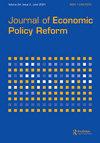Unconventional monetary policy and income disparity in an aging society
IF 3.2
3区 经济学
Q1 DEVELOPMENT STUDIES
引用次数: 8
Abstract
ABSTRACT The main objective of the Bank of Japan’s monetary policy is inflation targeting; however, it may be associated with the recently increased income disparity in Japan. Using the autoregressive distributed lag (ARDL) estimation model, this study conducted in the context of an aging society revealed that the bank’s monetary policy increased income inequality through increased financial asset prices, resulting in a widening of the income gap. We also find that in the long run, the aging population will increase income disparity in Japan; however, tax policy will partially mitigate the adverse effect on income inequality. Unconventional monetary policy will not bring a desirable result for the Japanese economy and the nation as a whole. In addition, the government needs to revise the incremental tax system so that wealthier groups pay more tax than before. In addition, expanding the tax system by adopting the carbon taxation scheme would be beneficial. The government with this kind of tax can pursue two major goals: reducing poverty and environmental pollution, which are ongoing challenges in Japan.非常规货币政策与老龄化社会中的收入差距
摘要日本央行货币政策的主要目标是通货膨胀目标;然而,这可能与日本最近收入差距的扩大有关。利用自回归分布滞后(ARDL)估计模型,本研究在老龄化社会背景下进行,揭示了银行的货币政策通过提高金融资产价格来加剧收入不平等,导致收入差距扩大。我们还发现,从长远来看,人口老龄化将加剧日本的收入差距;然而,税收政策将部分缓解对收入不平等的不利影响。非常规的货币政策不会给日本经济和整个国家带来理想的结果。此外,政府需要修改增量税收制度,使富裕群体比以前缴纳更多的税。此外,通过采用碳税计划来扩大税收体系将是有益的。拥有这种税收的政府可以实现两个主要目标:减少贫困和环境污染,这在日本是一个持续的挑战。
本文章由计算机程序翻译,如有差异,请以英文原文为准。
求助全文
约1分钟内获得全文
求助全文
来源期刊

Journal of Economic Policy Reform
Multiple-
CiteScore
6.60
自引率
0.00%
发文量
14
期刊介绍:
The Journal of Economic Policy Reform focuses on the analysis of economic policy reform. The journal draws upon what lessons can be learned from the successes and failures of countries undertaking reforms and how existing theories can be developed to shed light on positive as well as normative aspects of the reform process. The Journal of Economic Policy Reform encourages work from economists and political economy analysts on policies to promote growth and reduce poverty, intellectual property rights, aid versus trade, debt and debt relief, taxation and social security systems, surveys of key reform issues, as well as on corruption, democracy, emerging markets and the role of multilateral institutions.
 求助内容:
求助内容: 应助结果提醒方式:
应助结果提醒方式:


